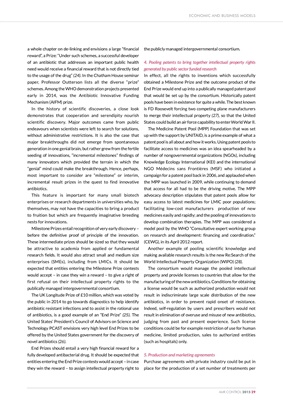
a whole chapter on de-linking and envisions a large "financial
reward", a Prize: "Under such schemes, a successful developer
of an antibiotic that addresses an important public health
need would receive a financial reward that is not directly tied
to the usage of the drug" (24). In the Chatham House seminar
paper, Professor Outterson lists all the diverse "prize"
schemes. Among the WHO demonstration projects presented
early in 2014, was the Antibiotic Innovative Funding
Mechanism (AIFM) prize.
In the history of scientific discoveries, a close look
demonstrates that cooperation and serendipity nourish
scientific discovery. Major outcomes came from public
endeavours when scientists were left to search for solutions,
without administrative restrictions. It is also the case that
major breakthroughs did not emerge from spontaneous
generation in one genial brain, but rather grew from the fertile
seeding of innovations, "incremental milestones" findings of
many innovators which provided the terrain in which the
"genial" mind could make the breakthrough. Hence, perhaps,
most important to consider are "milestone" or interim,
incremental result prizes in the quest to find innovative
antibiotics.
This feature is important for many small biotech
enterprises or research departments in universities who, by
themselves, may not have the capacities to bring a product
to fruition but which are frequently imaginative breeding
nests for innovations.
Milestone Prizes entail recognition of very early discovery -
before the definitive proof of principle of the innovation.
These intermediate prizes should be sized so that they would
be attractive to academia from applied or fundamental
research fields. It would also attract small and medium size
enterprises (SMEs), including from LMICs. It should be
expected that entities entering the Milestone Prize contests
would accept - in case they win a reward - to give a right of
first refusal on their intellectual property rights to the
publically managed intergovernmental consortium.
The UK Longitude Prize of £10 million, which was voted by
the public in 2014 to go towards diagnostics to help identify
antibiotic resistant infections and to assist in the rational use
of antibiotics, is a good example of an "End Prize" (25). The
United States' President's Council of Advisors on Science and
Technology PCAST envisions very high level End Prizes to be
offered by the United States government for the discovery of
novel antibiotics (26).
End Prizes should entail a very high financial reward for a
fully developed antibacterial drug. It should be expected that
entities entering the End Prize contests would accept - in case
they win the reward - to assign intellectual property right to
the publicly managed intergovernmental consortium.
4. Pooling patents to bring together intellectual property rights
generated by public sector funded research
In effect, all the rights to inventions which successfully
obtained a Milestone Prize and the outcome product of the
End Prize would end up into a publically managed patent pool
that would be set up by the consortium. Historically patent
pools have been in existence for quite a while. The best known
is FD Roosevelt forcing two competing plane manufacturers
to merge their intellectual property (27), so that the United
States could build an air force capability to enter World War II.
The Medicine Patent Pool (MPP) Foundation that was set
up with the support by UNITAID, is a prime example of what a
patent pool is all about and how it works. Using patent pools to
facilitate access to medicines was an idea spearheaded by a
number of nongovernmental organizations (NGOs), including
Knowledge Ecology International (KEI) and the international
NGO Médecins sans Frontières (MSF) who initiated a
campaign for a patent pool back in 2006, and applauded when
the MPP was launched in 2009, while continuing to demand
that access for all had to be the driving motive. The MPP
advocacy description stipulates that patent pools allow for
easy access to latest medicines for LMIC poor populations;
facilitating low-cost manufacturers production of new
medicines easily and rapidly; and the pooling of innovations to
develop combination therapies. The MPP was considered a
model pool by the WHO "Consultative expert working group
on research and development: financing and coordination."
(CEWG), in its April 2012 report.
Another example of pooling scientific knowledge and
making available research results is the new Re:Search of the
World Intellectual Property Organization (WIPO) (28).
The consortium would manage the pooled intellectual
property and provide licenses to countries that allow for the
manufacturing of the new antibiotics. Conditions for obtaining
a license would be such as authorized production would not
result in indiscriminate large scale distribution of the new
antibiotics, in order to prevent rapid onset of resistance.
Indeed, self-regulation by users and prescribers would not
result in elimination of overuse and misuse of new antibiotics,
judging from past and present experience. Such license
conditions could be for example restriction of use for human
medicine, limited production, sales to authorized entities
(such as hospitals) only.
5. Production and marketing agreements
Purchase agreements with private industry could be put in
place for the production of a set number of treatments per
ECONOMIC AND BUSINESS MODELS
AMR CONTROL 2015 29